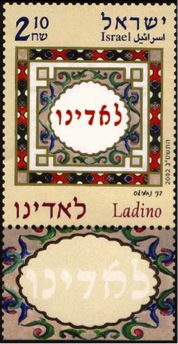By Emily K. Alhadeff , Associate Editor, JTNews
Do you speak Jewish?
It sounds like a funny question. How does one speak a religion, a culture, a people? Jews are Jewish. They speak Hebrew.
Or Yiddish. Or Ladino. Or Judeo-Iranian, or Judeo-Arabic, or even — according to linguist Sarah Bunin Benor and others — Jewish English, also known as “Yinglish” or “Hebonics.” Throughout time and from place to place, Jews have spoken their own Jewish language.
This, in relation to Judeo-Spanish, is the point Professor David Bunis made before a packed audience at Hillel at the University of Washington on October 9, at a talk titled “Ladino/Judezmo as a Jewish Language.”
Bunis is the University of Washington Schusterman Visiting Israeli Professor for 2013-2014, a position supported by the Stroum Jewish Studies Program, the Department of Spanish and Portuguese Studies, the American-Israeli Cooperative Enterprise (AICE), and the Samis Foundation.
Backed by a PowerPoint presentation, Bunis outlined the linguistic characteristics of Judezmo (a term he prefers to Ladino, which technically refers to a literal style of translation between Hebrew or Aramaic and the language of Sephardim) and the history of the language.
Judezmo originally meant “Judaism,” and by the 17th century, Judezmo was known in the Ottoman Empire as “the Jewish language.” Eighteenth-century Bible translations use Judezmo to mean Jews, or the Jews’ language. Like Yiddish, Judezmo was usually used in secular, profane contexts, while Hebrew was used in the holy sphere. Israel commissioned a commemorative Ladino stamp and may be establishing the first International Ladino Day on December 5 of this year.
Bunis, a Brooklyn, N.Y. native who now lives in Israel, first became interested in Judezmo in high school when he came across a chapter on Jewish languages in the book “College Yiddish.”
“I really became fascinated with [the language], and corresponded with its speakers,” he said.
By 1980, he had earned his doctorate from Columbia in linguistics, with a focus on the Hebrew-Aramaic component of Judezmo.
Since that time, he said, the interest in Judeo-Spanish and comparative Jewish languages has grown, particularly in Israel and Europe, where students are looking for new research angles.
“I think Judezmo is taken more seriously today,” he said. “It’s more widely known.”
A Jewish studies program open to a wide range of Jewish experiences and a strong connection between the academy and the community make the UW an ideal place for a scholar like Bunis, according to Devin Naar, the Marsha and Jay Glazer Assistant Professor in Jewish Studies. Naar heads the Sephardic Studies Initiative within the Stroum Jewish Studies Program.
In addition to spontaneous applause during the lecture, when Bunis played a Hebrew-Ladino recording of Hazzan Ike Azose’s “Ein K’Eloheinu,” many attendees began to sing along.
“Where else are you going to find a captive audience like that?” Naar asked. “Not even in Jerusalem could you get 150 people out [for a lecture] on Ladino. It never happens.”
In his opening address, Naar hailed the progress of Sephardic studies at the UW. Recently, he said, he received a call from Yeshiva University in New York asking for help with its Ladino materials. Who could imagine, mused Naar, Yeshiva University would turn to the University of Washington for anything Jewish?
Having Bunis here for the year “makes the UW one of the only — if not the only university in United States — where undergraduate students will have the opportunity to study the Ladino language in its historical and socio-linguistic contexts,” said Naar.
Bunis is teaching four courses this year, including Ladino for Beginners in the winter.
“I want to try to help students who are interested in furthering their knowledge in Judezmo,” said Bunis.
If students advance enough, he may even teach them to read the calligraphic script known as Soletreo. Bunis and Naar both emphasized the community’s relevance.
“You have here a swath of the Jewish community who has not seen its language and culture valorized and celebrated and canonized into the realm of Jewish studies in the academy in the way that Yiddish has,” said Naar. “Now we have that opportunity to demonstrate to the community why their heritage is really valuable.”
“The community itself seems to be very dedicated to their Sephardic traditions” Bunis noted. “That was really heartwarming.”
While Naar pointed out that the UW has always been engaged with Sephardic studies, the initiative is now officially being instituted in the Stroum Jewish Studies Program. An active advisory board chaired by Lela Franco, a member of the program’s advisory board and chair of the Sephardic Studies Initiative, is working with the community to shape its goals and vision.
Several of this year’s events will headline Sephardic content, including a lunch-and-learn with Prof. Ilan Stavans in January and “Mixing Musics: The Sacred Songs of Istanbul Jews” in February.
